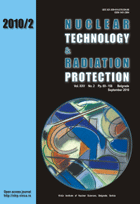
THE EFFECT OF AXIAL FUEL ROD POWER PROFILE ON FUEL TEMPERATURE AND CLADDING STRAIN

Vol.
XXV, No. 2, Pp. 69-156
September 2010
UDC 621.039+614.876:504.06
ISSN 1451-3994
Pages: 114-119
Authors: Kyu-Tae Kim
AbstractThe most limiting design criteria for nuclear reactor normal operating conditions (ANS Condition I) are known to be rod internal pressure and cladding oxidation, while those for nuclear reactor transient operating conditions (ANS Conditon II) to be fuel centerline temperature and transient cladding total tensile strain. However, the design margins against fuel temperature and transient cladding tensile strain become smaller since power uprating is being or will be utilized for the most of nuclear power reactors to enhance the economics of nuclear power. In order to secure sufficient design margins against fuel temperature and cladding total tensile strain even for power uprating, the current axial rod power profiles used in the reactor transient analysis were optimized to reduce over-conservatism, considering that 118% overpower of a steady-state peak rod average power was not exceeded during the reactor transients. The comparison of the current axial rod power profiles and the optimized ones indicates that the latter reduces the fuel centerline temperature and cladding total tensile strain by 26°C and 0.02%, respectively.
Key words: nuclear fuel rod, design criteria, fuel centerline temperature, cladding total tensile strain, axial rod power profile
FULL PAPER IN PDF FORMAT (793 KB)
Last updated on September, 2010